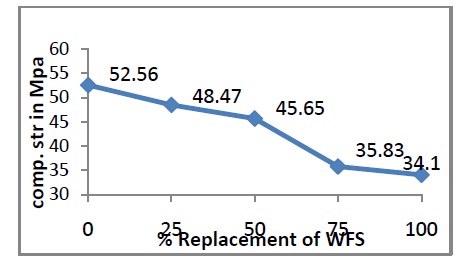





Published on Nov 30, 2023
The rapid development in India has led to the increased growth of industrial sector. Foundry sand is high quality silica sand which is a by-product of ferrous and non-ferrous metal casting industries, where sand is used as a moulding material. When the sand can no longer be reused in the foundry, it is removed from the foundry and is termed as Foundry waste sand. Approximately 45 foundry industries are located in Belgaum city out of which 18 are situated in Udyambag. The waste disposal methods adopted by the foundry industries causes severe problems related to disposal of waste foundry sand which consumes local landfill space.
The construction industry is emerging as a developing potential in the country due to this development there is an increase in the raw materials required for construction purpose. Natural sand is one of the main constituents of concrete and has been used widely in construction activities and is diminishing day by day.These resources are also exhausting rapidly due to mining operations.
Due to the rising cost of raw materials and the continuousdepletion of natural resources, the use of waste materials andindustrial by-products is a potential alternative in the constructionindustry to achieve sustainable development. Hence there arises a need to substitute the natural river sand as fine aggregates by waste foundry sand.
The waste foundry sand can be used as a replacement for river sand in the manufacture of paver blocks which can be used for non-traffic condition where strength is not the main criteria. Hence, by using foundry sand as an alternative, the disposal problems of waste foundry sand and the scarcity of river sand can be resolved.
Keywords : River sand, foundry sand, paver blocks, plastic mould method, hydraulic press, sustainability
The project mainly emphasizes upon the replacement of river sand by waste foundry sand in various increasing percentages of 0%, 25%, 50%, 75%, and 100% in the manufacture of paver blocks.
1. The pavers are manufactured by two methods namely;
a. Rubber mould method
b. Hydraulic press method
2. Various tests are conducted for the parameters given below according to IS:15658-2006,
a. Compressive strength
b. Water absorption
c. Split tensile strength
d. Flexural strength
e. Abrasion resistance
3. A comparative study is done on the test parameters for various percentages of replacement in both the methods of manufacture.
4. An optimum percentage of replacement is to be found from both the methods of manufacture
5. Paver blocks are designed for non-traffic condition which can be used for footpath, parking, building premises and so on.
Ordinary Portland Cement (OPC) 43 grade- IS: 8112-2013
Fine aggregates- IS 383-2016
Coarse aggregates- IS 383-2016
Water- IS 456-2000
Admixture- IS 9103- 2013
White cement- IS: 8042-2015
Dolomite powder
The paver blocks are manufactured by two methods namely;
In this method, the pavers are manufactured by using a suitable mix design for M30 grade of concrete. The mix proportion adopted is 1:2.1:1.9. The pavers are manufactured in two layers; the first layer is the wearing layer and is 10 mm thick.
In this method, the pavers are manufactured by using a hydraulic press machine for a suitable mix design of M30. The mix proportion adopted is 1:1.53:2.21. The mix prepared is comparatively dry and the pavers are made by the application of pressure.
1. Compressive strength

The compressive strength of the paver blocks decreases as the percentage replacement by waste foundry sand increases. The target strength as per the mix design in IS: 10262-2006 is obtained at 50% replacement.

The water absorption in % increases as the percentage replacement by foundry sand increases. The water absorption should be restricted to 6%.

The flexural strength decreases upto 50% replacement by waste foundry sand. The minimum breaking load for residential pathway and pedestrian paths is 2 kN as per IS: 15658-2006 which is satisfied.
1. From the experimental results it can be seen that waste foundry sand can be used as replacement in paver blocks in non-traffic condition where strength is not the main criteria.
2. The compressive strength at 50% replacement by waste foundry sand gives the target strength as per the mix design conforming to IS 10262-2009. Hence 50% replacement is taken as the optimum percentage replacement.
3. The optimum percentage replacement for water absorption, flexural strength, tensile splitting strength and abrasion resistance is 50%
4. The optimum percentage replacement by WFS for abrasion resistance is 50%.
5. The waste foundry sand disposed from industries consumes large landfill space, causes soil pollution, contaminates the ground water by leaching, hence the present study benefits the reuse of the foundry sand in a sustainable manner.
6. Out of 45 foundry industries located in Belgaum city, 29 are situated in Udyambag which is an industrial hub area and hence the study is feasible in surrounding areas since there is adequate availability of foundry sand.
1. The replacement of waste foundry sand can be done in combination with various alternatives like M-sand which can give additional strength to the paver blocks and can also be used in low traffic condition areas.
2. The rate of gain of strength for various replacement mixes for a period of 7, 14 and 28 days can be further studied.
3. The paver blocks can be tested for its durability strength
4. In areas of adverse climatic condition, the pavers are to be tested for freeze-thaw durability according to Annexure H of IS: 15658-2006.